Veteran Ocean Sailor To Cross the Atlantic on 21-Foot Sailboat
The last time Canadian Alan Mulholland attempted a long-distance ocean cruising voyage, he ended up upside down in his 26-foot Contessa sailboat in howling seas 600 miles from land.
“I was below. All of a sudden, a rogue wave picked up the boat and slammed it down. Me with it! We rolled over. Got her back upright. It wasn’t until a day later that I discovered I had cracked two ribs. The boat needed some repairs, so I headed to the Caribbean. This was just when Covid was running rampant. I spent three months refitting and contemplating my next move.”
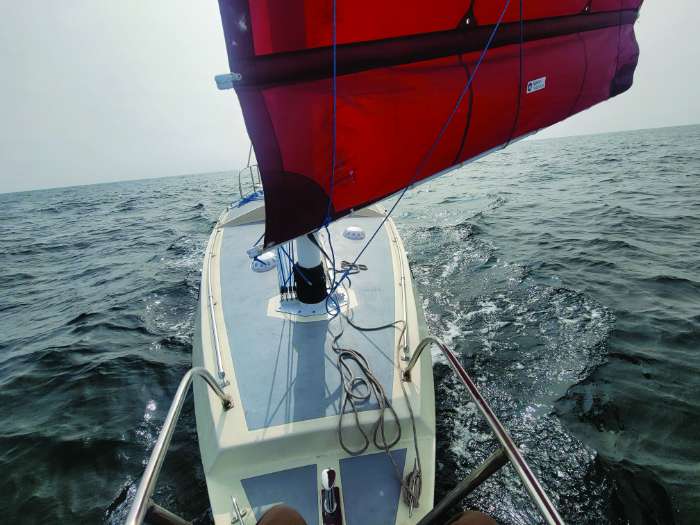
The sailor eventually made a non-stop voyage of 1600 miles from the Caribbean to his home port of Charlottetown, Prince Edward Island (PEI).
“I learned a lot from that experience,” the 59-year-old native of PEI said. “I spent a lot of time as I returned to port figuring out what had gone wrong and what I could do better the next time.”
The “next time” has come as Mulholland is just a few months away from the second leg of his attempt to sail a small boat he designed and built himself across the open ocean.
After a 100-day voyage from Charlottetown, PEI, last fall, the sailor battled wind and weather for the first two months of his trip as he tried to outrun a series of Atlantic lows that brought unprecedented wind and rain to the East Coast.
Presently Mulholland’s new home-built craft, Wave Rover 650, is in a boatyard in Maryland awaiting a weather window for the crossing from the East Coast to the Azores. Mullholland will sail down the Bay to Norfolk in April.
“My plan is to head across at the mid-end of May,” Mullholland told SpinSheet. “After the Azores, I’ll set sail for Ireland in late July. I’ll cruise around Ireland until the fall. I am sure Wave Rover is up to the challenge. I know I am.”
A bucket-list trip
Mulholland’s dream of a long-distance voyage in a boat of his own design and construction is not a unique one. Many a sailor has dreamed of fulfilling a bucket-list trip like his.
But few could imagine going across the Atlantic in a tiny 21-foot-long, 3000-pound, twin-keel, home-built sailboat powered by a 230-square foot junk-rig sail with a whopping 6-hp auxiliary motor for back-up propulsion.
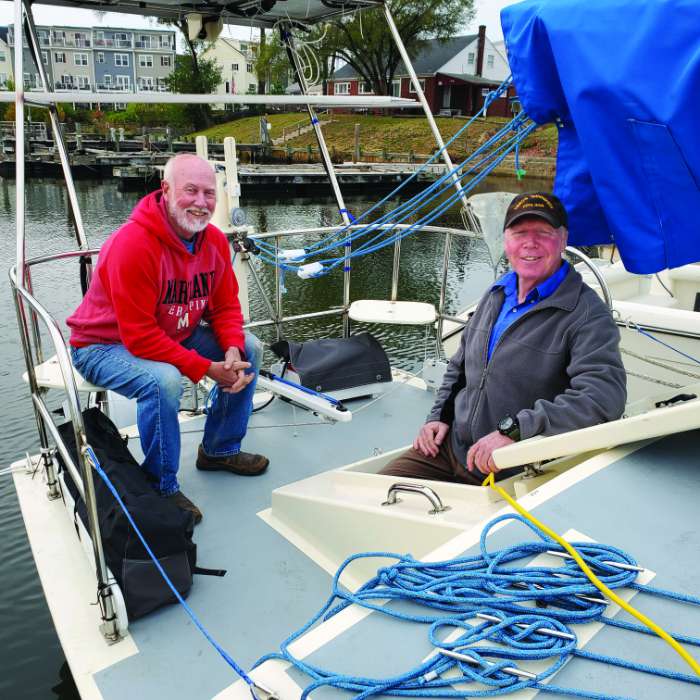
“Heck,” the self-effacing carpenter-turned-boatbuilder said, “the boat is solid, but we shaved costs wherever we could… like building the mast out of regular lumberyard two-by-fours.”
Such are the circumstances of Mulholland as he attempts to complete the voyage he first began three years ago, hopefully being able to turn his first nightmarish voyage into the fulfillment of a dream of a lifetime.
Mulholland is no stranger to long-distance cruising. In 1995, he sailed a 26-foot steel-hulled sloop he built himself from the Canadian West Coast to Brisbane, Australia. The voyage took four months with long distance hops to Hawaii, the Gilbert Islands, and finally to Brisbane.
“Lots of open ocean. Lots of time to think about life,” he said.
Even though the trip is touted as a “solo” voyage, thanks to a robust YouTube audience of more than 40,000 followers, Mulholland will hardly be alone. He plans to upload a number of videos chronicling his voyage.
Mulholland has already produced more than 100 episodes for the social network channel detailing the design and build of his unique craft.
“The Wave Rover 650 is a fast, safe, self-righting, easy-to-build, easy-to-sail boat that went from concept to reality over a period of 24 months,” he says.
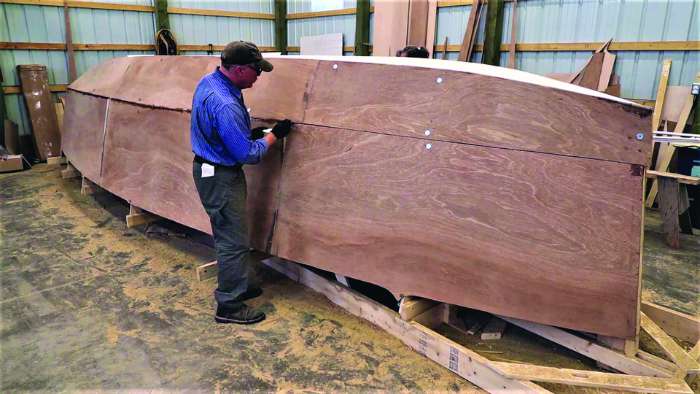
A partner in design
Mulholland hooked up via email and countless phone calls with Baltimore-based naval architect Andy Dize, recently retired from the Coast Guard, who has spent a lifetime on the water, sailing, designing, and building pleasure and commercial vessels of all shapes and sizes.
Dize, a graduate of New York Maritime College, has been a naval architect for 45 years. He’s raced sailboats around the buoys and offshore for 55 years, currently racing a Soling out of Severn Sailing Association. Some of his more notable designs include the two-masted gaff-rigged schooner Liberté currently sailing out of Annapolis and the Georgetown Canal Boat based in Washington, DC.
“Mulholland got in touch with me via a friend,” Dize says. “He explained his concept and his dream. We outlined the parameters of the boat, and we got to work collaborating on a boat that would fulfill his desires within the context of a structurally sound boat capable of going anywhere the wind blows.”
The first time the two met was when Mulholland sailed into Baltimore in late October.
“We had a great long-distance relationship. We worked the design out over the phone and with lots of emails,” Dize says. “When I first saw her approaching my dock, I had to pinch myself. She looked great. It’s fun to see your ideas come to life.”
Mulholland’s solo adventure was originally intended to be a multi-year, multi-stop solo circumnavigation.
“Reality sunk in as I was finishing the build. I really don’t have anything to prove. One thousand miles offshore is the same as 10,000 miles offshore. Besides, the thought of 50-60 days at sea was a little too daunting given my circumstances of a wife who I would have missed very much.”
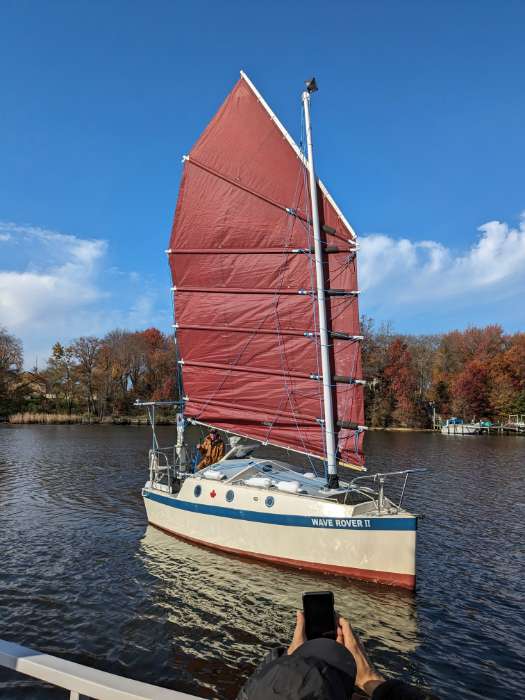
The new pocket cruiser
The Wave Rover 650 is a hard-chined Sharpie-design built on a wooden frame overlaid with nine-millimeter marine plywood coated with fiberglass cloth and resin. The two 600-pound twin keels are set at a 15-degree angle, which makes the keel perpendicular to the water when the boat is heeled over at its ideal 10-15 percent; this increases speed with minimum drag. There is plenty of floatation fore and aft. Two quarter berths and sufficient storage under the cabin sole complete the package.
Mulholland has installed a 300-watt solar charging system which keeps his 200-amp-hour LiFePro batteries charged. Wave Rover II has a water capacity of 170 liters.
Mulholland figures someone with moderate carpentry skills could build the Wave Rover 650 in about seven to eight months. He has about $10,000 invested in materials. He was fortunate to receive funding from 120 contributors whose names are on the Benefactors Bulkhead in the boat. Mulholland’s wife of 25 years, Glenda, aka Mrs. Rover to the You Tube community, has painstakingly inscribed the names of all contributors on the forward bulkhead. Some portion of the materials was donated to keep expenses down.
Mulholland and Dize are currently selling study plans and construction plans for the Wave Rover 650. At press time the duo has sold about two dozen construction plans to potential boat builders all over the world. Study plans cost $40. A full set of construction plans costs $450.
For Mulholland, the most important part of his upcoming sailing adventure is not the journey itself, what he may accomplish at sea, or even if he accomplishes his goal. Instead, it’s about reaching his potential and pushing himself.
“For me, to do the same job day after day would not be going anywhere near what I consider my potential,” he said. “Potential comes out of challenges that are just out of reach, and you can almost touch them. That’s what the sailing is for me, that’s what the building of the boat has been.”
The Wave Rover 650 was purpose-built to carry a solo sailor across the Atlantic and back.
“The boat had to be strong enough to cross the Atlantic. She needed to have sufficient capacity to carry 60 days of supplies yet be light enough to be propelled by a three to four horsepower motor. Most of all, she had to be comfortable at sea with a rig that was easy to control and repair.”
Wave Rover 650 was also built to optimize the use of a Mulholland-designed self-steering rig.
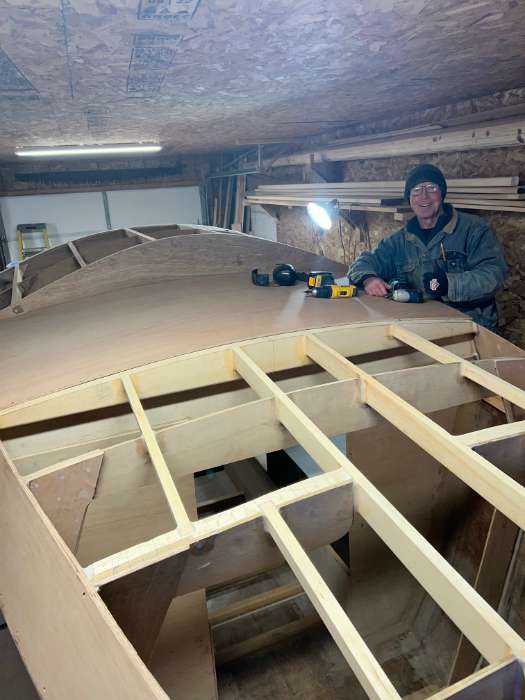
Mulholland and Dize selected the “junk” rig because it was simple and easy to build and reef. In tests, the rig performs well off the wind, although Mulholland and Dize figure she can go 45-55 degrees to windward which, they say, is a reasonable amount for a small, light boat.
The mast, which projects 21 feet from the deck, is unstayed, “but strong enough to withstand excessive loads.’” Her 230-square-foot junk rig can be depowered in seconds all from the safety of the cockpit. When reefed, the center of effort of the sail stays the same as panels of sail are folded on top of one another.
Just like the boat itself, communications and navigation are simple: Mulholland relies on two “cheap” tablets and a newish cell phone to run his Navionics navigation program. He sends and receives text messages underway via a Garmin In-Reach communicator; he keeps aware of other boats with an active AIS system “that drives me crazy when we are in a busy shipping lane.”
The little junk rig can skip along over the waves at around five to six knots “given decent wind” he says. Auxiliary power is provided by a six-horsepower Tohatsu outboard.
The advantage of twin bilge keels, Mulholland says, is that they reduce roll and serve as a handy cradle if the boat is beached for repairs.
Forging your own adventure
While the first couple of months at sea provided a test of men and machine, Mulholland anticipates the rest of his voyage to be “lots of fun with new experiences around every wave.”
Mulholland says, “A funny thing happened to me as I worked my way down the East Coast. I always thought of myself as a long-distance cruiser, but I have really enjoyed taking my time coming down here. I look forward to gunkholing around the Chesapeake en route to Ireland. This little boat is ideal for short jaunts in skinny water as well as handling big waves out on the ocean.”
The motto of Wave Rover II is: “Forge your own adventure.”
“I’m not into records,” says Mulholland. “I want to enjoy the experience, share my adventures with my YouTubers, meet some interesting people, and live to tell about it.”
~By Craig Ligibel




